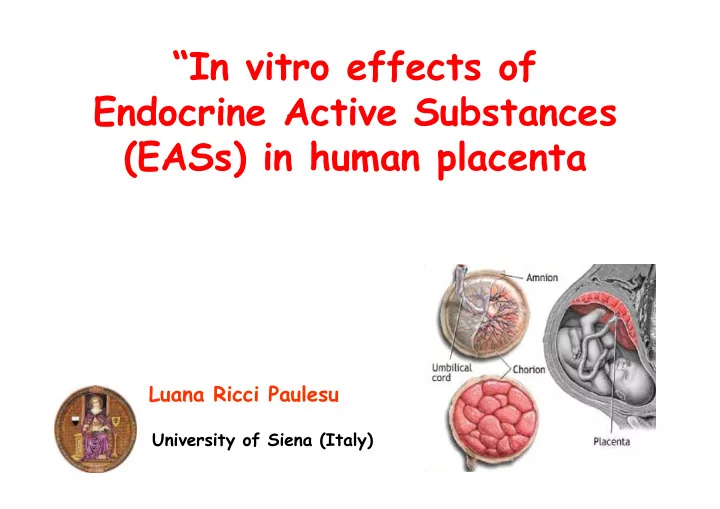

“In�vitro�effects of� Endocrine�Active Substances (EASs)�in�human placenta Luana�Ricci�Paulesu University�of�Siena�(Italy)
Human placenta ● Transfer�of�nutrients,� gases and�waste products ● Secretion�of�hormones ● Metabolism ● Immunological�barrier
Adverse factors ?
Selected chemicals: Para&nonylphenol ( p &NP):� alkylphenol used�in�detergents,� emulsifiers�and�solubilizers Bisphenol&A (BPA):� additive�of�plastics,�mainly� polycarbonates BPA�and� p &NP:�two estrogen&like substances Soto et al.,�Environ� Health�Perspect,�1991 Welshons et al.,� Endocrinology,�2006
In�vitro�models for studies in�human placenta Trophoblast&like cell lines:� BeWo, HTR&8/Svneo . Primary cultures: Placenta�Villous explants
Placenta�establishment�and�development�in�the�uterus HTR&8/Svneo BeWo ������� �����������������������
The�model�of�placenta�villous explants matrigel 24h 48&96h
In�vitro�studies�on�the�effects�of�EDCs in� human�placenta: 1.Toxicological�studies (on�trophoblast cell lines) 2.�Functional studies (on�trophoblast cell lines and� on�placenta�villous explants)
Toxicological studies: Treatment: Vehicle: (Control) � !NP /�BPA (0.01�pM – 1�mM) 24h BeWo/ HTR! 8/Svneo cells Cell viability
�� %�Cell viability 1.�Analysis of a�wide�range of concentrations Toxicological studies: ��� �� �� �� �� � 120 160 40 80 C 0.01�p M 0 C 0.01�p M 0.1�p M 0.1�p M 1�p M 0.001�n M 1�p M 0.001�n M 0.01�n M 0.01�n M 0.1�n M 0.1�n M 1�n M 1�n M 10�n M 10�n M 100�n M 100�n M 1� �M 1� �M 10� �M 10� �M 1�m M 1�m M p &NONYLPHENOL ( � !NP) BISPHENOL&A� (BPA)
�������������� ��� �������������������
Toxicological studies 2.�Analysis of the�range of concentrations near toxicity 120 120 100 100 p &NP Cell�viability�(%�over�CTRL) 80 60 80 40 LC 50 Cell viability (%) 60 20 0 M M M M M M 40 M M ? ? ? ? M ? m ? 1E&06 1E&05 � 3E&05 � 6E&05 0,0001 0,0001 0,0002 0,0005 m 0,001 � � 0 � 0 0 m 0 5 � � 5 1 5 3 6 0 2 5 � 1 2 1 1 1 . . 0 20 0 0 !7 !6 !5 !4 !3 !2 120 Log�[p!NP]�(M) 120 100 BPA 80 100 Cell�viability�(%�over�CTRL) 60 80 40 LC 50 20 60 0 M M M M M M M M M M M M M 40 M ? ? ? ? ? m ? ? ? ? ? m m � � � ? � � � � � � � � 0 0 0 0 0 5 � 5 0 0 5 � 5 � 3 5 8 2 1 1 6 0 0 0 1 2 6 . 2 1 4 1 2 2 0 1 1 20 . 1 0 0 !7 !6 !5 !4 !3 !2 Log�[BPA]�(M)
Results from the�toxicological studies: Both chemicals tested (BPA�and� p &NP)� caused�toxicity�in�human�trophoblast cells�at�concentrations ranging from 10�?M�to 1mM.
Non&toxic concentrations selected for functional studies in�human trophoblast:� 10�pM ! 0.1 � � M � � The�concentrations selected were also easily found in�the� environment and�in�human tissues
Functional studies:� Differentiation of ST trophoblast: β &hCG secretion β β β Caspase&3
Functional studies:� β β β β �hCG 7.5 β !hCG β β β � g �o f�p r o te in 6.0 4.5 3.0 Treatment: � m I U / � � 1.5 Vehicle: � !NP /�BPA 0.0 (Control) C BPA p�NP Caspase!3 BeWo /� placenta� explants C���� � �NP BPA
Non&toxic,�environmentally relevant concentrations of BPA�and� p &NP induce� the� β β &hCG and�caspase&3�activation in� β β human trophoblast p &NP BPA 10�pM!0.1� � � � M � 10�pM!0.1� � � � � M β &hCG β β β Caspase 3
���������� � Both chemicals tested (BPA�and� p &NP)�exerted toxicity on�human trophoblast at�concentrations�not� achieved�in�the�environment�(from�10�?M�to 1mM); � Both chemicals however increased the�differentiative pathway of trophoblast at�non&toxic,�environmentally relevant concentrations (from 10�pM to 0.1� � � M); � � � The�results�obtained�raise�great�concern�about�the� environmental�risk�to�health,�and�point�to�the�need�for� protecting�both�pre&natal�life�and�development�of�the� foetus from�contamination.
Francesca�Ietta Nicoletta Bechi Roberta�Romagnoli Chiara Mannelli Antonella Spagnoletti University�of�Siena Partially�supported�by�the�European� Siena�(Italy)� Sixth�framework�programme (Project:�ReProTect)
Recommend
More recommend